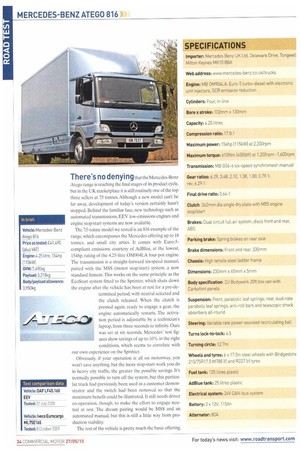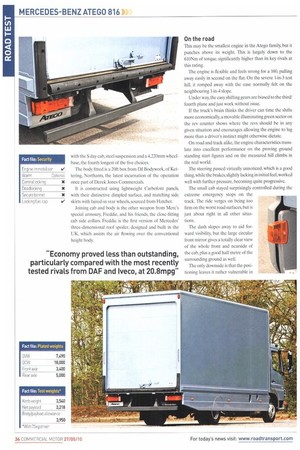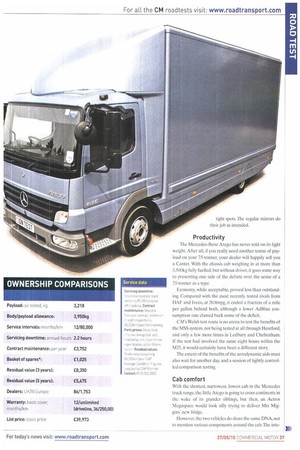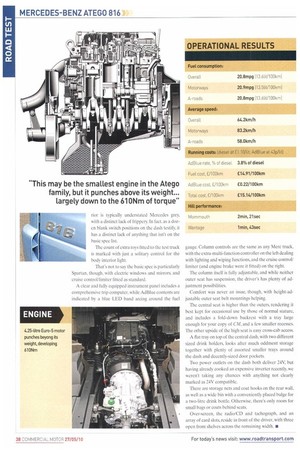There's no denying that the Mercedes-Benz Atego range is reaching
Page 34

Page 36

Page 37

Page 38

If you've noticed an error in this article please click here to report it so we can fix it.
the final stages of its product cycle. but in the UK marketplace it is still routinely one of the top three sellers at 73 tonnes. Although a new model can't be far away, development of today's version certainly hasn't stopped. Behind the familiar face, new technology such as automated transmissions, EEV low-emissions engines and engine stop/start systems are now available.
The 7.5-tonne model we tested is an 816 example of the range, which encompasses the Mercedes offering up to 18 tonnes, and small city artics. It comes with Euro-5compliant emissions, courtesy of AdBlue, at the lowest, 154hp, rating of the 4.25-litre 0M904LA four-pot engine. The transmission is a straight-forward six-speed manual, paired with the MSS (motor stop/start) system, a now standard fitment. This works on the same principle as the EcoStart system fitted to the Sprinter, which shuts down the engine after the vehicle has been at rest for a pre-determined period, with neutral selected and the clutch released. When the clutch is pressed again, ready to engage a gear, the engine automatically restarts. The activation period is adjustable by a technician's laptop, from three seconds to infinity. Ours was set at six seconds. Mercedes' test figures show savings of up to 10% in the right conditions, which seems to correlate with our own experience on the Sprinter.
Obviously, if your operation is all on motorway, you won't save anything, but the more stop-start work you do in heavy city traffic, the greater the possible savings. It's normally possible to turn off the system, but this particular truck had previously been used as a customer demonstrator and the switch had been removed so that the maximum benefit could be illustrated. It still needs driver co-operation, though, to make the effort to engage neutral at rest. The dream pairing would be MSS and an automated manual, but this is still a little way from production viability.
The rest of the vehicle is pretty much the basic offering.
with the S day cab, steel suspension and a 4,220mm wheelbase, the fourth longest of the five choices.
The body fitted is a 20ft box from DJ Bodywork, of Kettering, Northants, the latest incarnation of the operation once part of Derek Jones Commercials.
It is constructed using lightweight Carbofont panels, with their distinctive dimpled surface, and matching side skirts with faired-in rear wheels, sourced from Hatcher.
Joining cab and body is the other weapon from Merc's special armoury, Freddie, and his friends, the close-fitting cab side collars. Freddie is the first version of Mercedes' three-dimensional roof spoiler, designed and built in the UK, which assists the air flowing over the conventional height body.
On the road
This may be the smallest engine in the Atego family, but it punches above its weight. This is largely down to the 610Nrn of torque, significantly higher than its key rivals at this rating.
The engine is flexible and feels strong for a 160, pulling away easily in second on the flat. On the severe 1-in-3 test hill, it romped away with the ease normally felt on the neighbouring 1-in-4 slope.
Under way, the easy shifting gears are biased to the third/ fourth plane and just work without issue.
If the truck's brain thinks the driver can time the shifts more economically, a movable illuminating green sector on the rev counter shows where the revs should be in any given situation and encourages allowing the engine to lug more than a driver's instinct might otherwise dictate.
On road and track alike, the engine characteristics translate into excellent performance on the proving ground standing start figures and on the measured hill climbs in the real world.
The steering passed virtually unnoticed, which is a good thing, while the brakes, slightly lacking in initial feel, worked well with further pressure, becoming quite progressive.
The small cab stayed surprisingly controlled during the extreme emergency stops on the track. The ride verges on being too firm on the worst road surfaces, but is just about right in all other situations.
The dash slopes away to aid forward visibility, but the large circular front mirror gives a totally clear view of the whole front and nearside of the cab, plus a good half metre of the surrounding ground as well.
The only downside is that the positioning leaves it rather vulnerable in
Productivity
The Mercedes-Beni Atego has never sold on its light weight. After all, if you really need another tonne of payload on your 7.5-tanner, your dealer will happily sell you a Canter. With the chassis cab weighing in at more than 3,500kg fully fuelled, hut without driver, it goes some way to presenting one side of the debate over the sense of a 25-tonner as a type.
Economy, while acceptable, proved less than outstanding. Compared with the most recently tested rivals from DAF and Iveco, at 20.8mpg, it ended a fraction of a mile per gallon behind both, although a lower AdBlue consumption rate clawed back some of the deficit.
CM's Welsh test route is no arena to test the benefits of the MSS system, not being tested at all through Hereford, and only a few more times in Ledbury and Cheltenham. If the test had involved the same eight hours within the M25, it would certainly have been a different story.
The extent of the benefits of the aerodynamic aids must also wait for another day, and a session of tightly controlled comparison testing.
Cab comfort
With the shortest, narrowest, lowest cab in the Mercedes truck range, the little Ales° is going to cross continents in the wake of its grander siblings, but then, an Actros Megaspace would look silly trying to deliver Mrs Miggins' new fridge.
However, the two vehicles do share the same DNA, not to mention various components around the cab. The inte nor is typically understated Mercedes grey, with a distinct lack of frippery. In fact, as a dozen blank switch positions on the dash testify, it has a distinct lack of anything that isn't on the basic spec list.
The count of extra toys fitted to the test truck is marked with just a solitary control for the body interior light.
That's not to say the basic spec is particularly Spartan. though. with electric windows and mirrors, and cruise control/limiter fitted as standard.
A clear and fully equipped instrument panel includes a comprehensive trip computer, while AdBlue contents are indicated by a blue LED band arcing around the fuel gauge. Column controls are the same as any Mere truck, with the extra-multi-function controller on the left dealing with lighting and wiping functions, and the cruise control/ limiter (and engine brake were it fitted) on the right.
The column itself is fully adjustable, and while neither outer seat has suspension, the driver's has plenty of adjustment possibilities.
Comfort was never an issue, though, with height-adjustable outer seat belt mountings helping.
The central seat is higher than the outers, rendering it best kept for occasional use by those of normal stature, and includes a fold-down backrest with a tray large enough for your copy of CM, and a few smaller recesses. The other upside of the high seat is easy cross-cab access
A flat tray on top of the central dash, with two different sized drink holders, looks after much oddment storage together with plenty of assorted smaller trays around the dash and decently-sized door pockets.
Two power outlets on the dash both deliver 24V, but having already cooked an expensive inverter recently, we weren't taking any chances with anything not clearly marked as 24V compatible.
There are storage nets and coat hooks on the rear wall, as well as a wide bin with a conveniently placed bulge for a two-litre drink bottle. Otherwise, there's only room for small bags or coats behind seats.
Over-screen, the radio/CD and tachograph, and an array of card slots, reside in front of the driver, with three open front shelves across the remaining width. m
































































































































